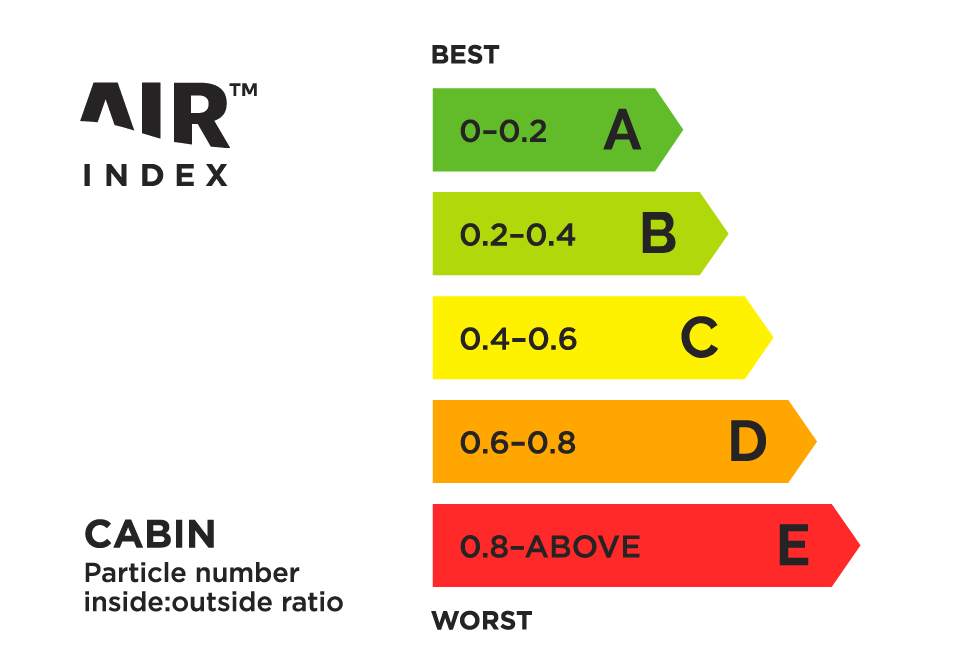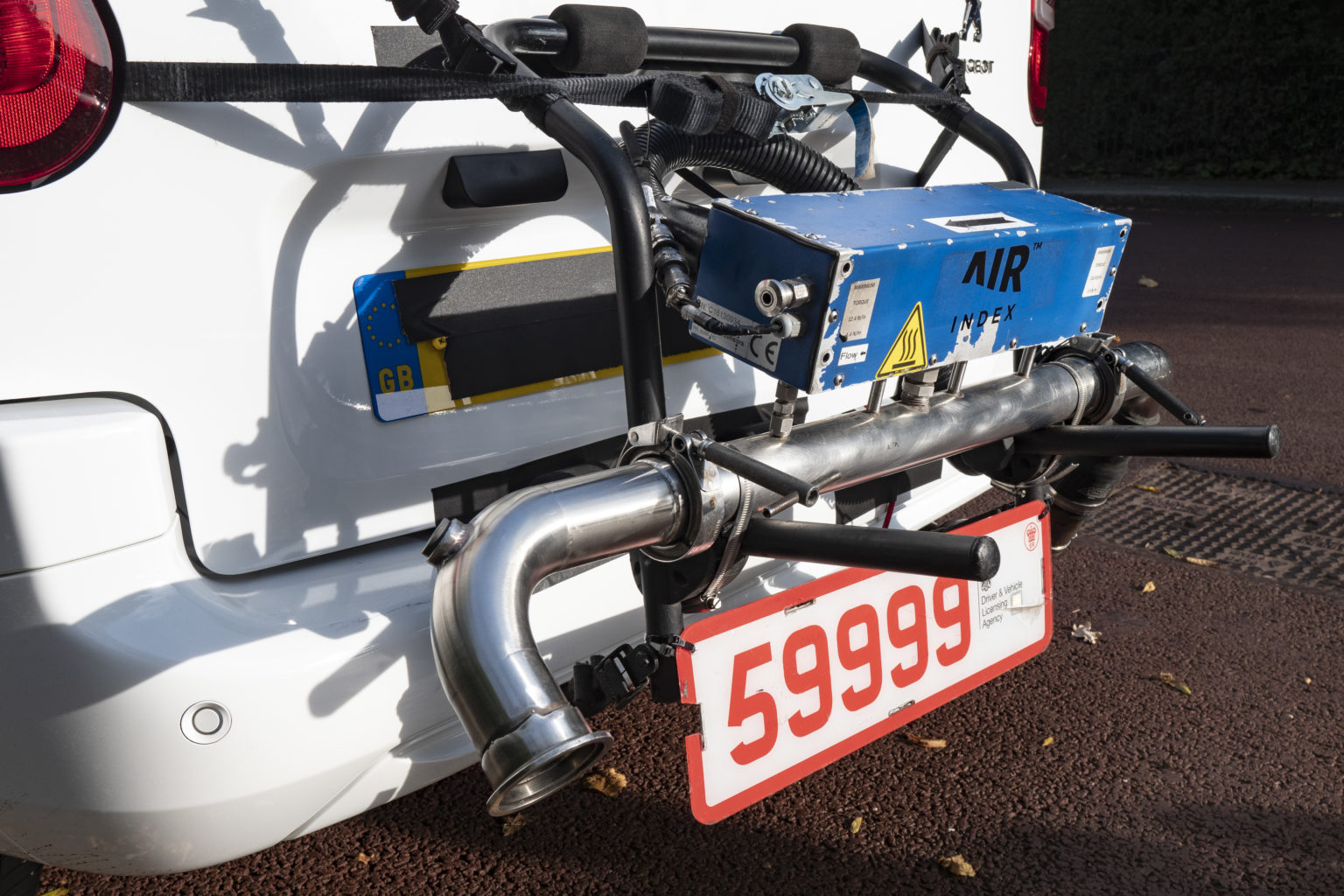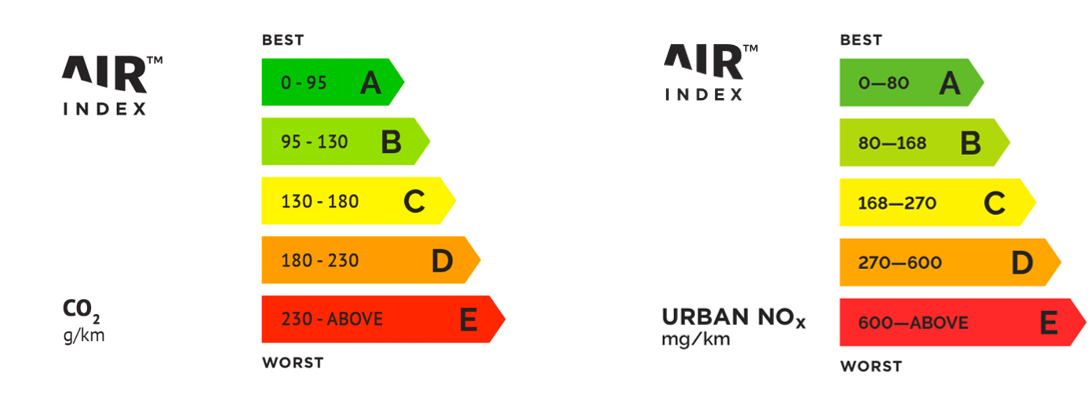NEW international Cabin AIR Index launched
Fleet owners, policy makers and drivers now have access to independent, standardised vehicle ventilation ratings
- Easy to understand and comparable ratings provide clarity for drivers and car buyers.
- The first independent data set enabling policy makers to protect vehicle occupants.
- The independent Cabin AIR Index rates the ability of each filter and ventilation system to protect vehicle occupants from exterior pollution.
- The A-E colour-coded rating is endorsed by global air quality and vehicle emissions experts.
- Moe information available at www.airindex.com/emissions-ratings/cabin-air-quality-in-cars/
25 July 2023: Today’s launch of the Cabin AIR Index reveals, for the first time using scientific data, the effectiveness of vehicle ventilation systems and the choice of filters in reducing the exposure of vehicle occupants to harmful pollutants.
Developed from more than five years of independent, international research the new Cabin AIR Index ratings reveal accurately how much pollution enters a vehicle compared to the outside air, when it is used in towns and cities.
Exposure to high levels of pollutants in the air can cause a range of serious health issues including respiratory problems, heart disease, strokes and lung cancer1.
The air quality inside cars and vans (M1 and N1 categories2) is unregulated, leaving drivers and passengers unaware of the levels of exposure to damaging pollutants. In Europe alone, air pollution is estimated to cause more than 300,000 premature deaths each year3.
The Cabin AIR Index has been created to inform and empower drivers, passengers, fleet owners and policy makers with the real facts about the protection offered by the ventilation systems and filters in the cars they use and travel in. A simple A-E colour-coded rating, based on a new real-world standard, shows the difference in effectiveness in filtering harmful pollutants.
In 2021 more than 97% of the urban population was exposed to concentrations of fine particulate matter above the health-based guideline level set by the World Health Organization4. Drivers and passengers, and in particular professional drivers who are in vehicles for several hours each day are now able to compare vehicles and the filter systems, enabling choice, for the first time based on scientific data.
Today’s launch of the Cabin AIR Index also reveals the significant variation in protection offered by the same vehicle, depending on the type of interior air filter used. When tested on the same car, the combination of ventilation system and one filter was only able to reduce the level of exposure to outside particles for drivers and passengers by 30% during the course of the test, whilst the best performing combination of system and filter achieved 82%.
The Cabin AIR Index ratings show ‘at a glance’ how effective the vehicle ventilation system is, allowing comparison with other vehicles, and other filters installed based on scientifically robust, repeatable, on-road vehicle testing according to the new CWA 17934 methodology.
Massimo Fedeli, Co-founder and Operations Director of the AIR Alliance said: “The health effects of breathing fine particulate matter in urban air are now, sadly, well established and estimated to cause more than 300,000 premature deaths in Europe each year. Drivers and passengers in urban areas may assume that closing windows and using the ventilation system prevents exposure to particulate matter, but that is not necessarily the case.
“Following five years of research, today the AIR Alliance is launching the Cabin AIR Index which rates the ability of the ventilation system to filter the number of particles from outside the vehicle and presents the results in a simple A-E colour coded scale.
“The Cabin AIR Index is the first opportunity for drivers and passengers to see the protection offered by vehicle ventilation systems, and also reveals the difference in performance between different filters fitted to the same vehicle, enabling drivers to make a choice when selecting the filter for their car or van.”
Nick Molden, Co-founder of the AIR Alliance said: “The Cabin AIR Index is based on data collected according to the CWA 17934 methodology, the independent, scientifically robust methodology to collect real drive vehicle interior air quality data. In the absence of any regulations for air quality inside cars and vans, drivers and passengers are unaware of the levels of pollution, and in particular the number of particles which enter the cabin.
“Drivers, and especially professional drivers who are in the vehicle for several hours each day, should be aware that the choice of interior air filter can make a significant difference to the quality of air that they breathe. Our tests show that the same ventilation system fitted with different, but compatible filters, reduced the level of exposure to outside particles for drivers and passengers between 30% and 82%.
“We have worked hard over the last three years with our independent, expert academic and industry group to define standardisation of data collection through the CEN Workshop Agreement 17934. We rate data collected by this method on the Cabin AIR Index providing comparative information between vehicles using fair testing criteria, all conducted on-road in real driving conditions. The same standardised test is applied to each different car type.
“For the first time policy makers and fleet owners have the ability to protect vehicle occupants, using the Cabin AIR Index to define the minimum standards expected to protect occupants.”
The results of the seven filters tested for the AIR Alliance on a 2018 Nissan Qashqai and rated in the Cabin AIR Index are:

*Cabin Air Quality Index (CAQI) as defined in the CWA Workshop Agreement 17934
**the age, make and part number of the interior filter which was pre-installed in the test vehicle was unknown.
The AIR Alliance has now commissioned a programme of vehicle and filter testing and more results will be added to the Cabin AIR Index periodically.
About the Cabin AIR Index
Vehicle ventilation systems for cars and vans (M1 and N1 categories2) rated for the Cabin AIR Index are tested according to the CWA 17934 standardised methodology which ensures that the results are independent, repeatable and comparable.
The testing is carried out on a vehicle, sourced independently from vehicle manufacturers, with Pollution In-cabin Emissions Measurement Systems (PIMS) equipment recording the air quality inside and outside the vehicle during on-road driving in towns and cities.
For a result to be considered acceptable for rating in the Cabin AIR Index at least three sperate tests must be conducted on each model, within specific boundary conditions5 at an average speed between 30 km/h and 50 km/h, with each test lasting at least 30 minutes.
Testing is conducted with the ventilation system in ‘fresh air’ mode, the air conditioning turned off, and temperature set to 19°C in either automatic mode, or 50% fan speed if manual, and the vents facing forward and level.
The results of the tests provide the basis to rate the vehicle ventilation systems according to the A-E, colour-coded scale.

The AIR Index website reports the first tests conducted on a single vehicle with different filters showing Cabin AIR Index ratings A-E. Car buyers and fleet operators should consider carefully the implication for the health of vehicle occupants when selecting the vehicle and choice of filter to minimise the ingress of harmful particles.
Background to the Cabin AIR Index testing process
Emissions Analytics, founded by Nick Molden (Co-founder of the AIR Alliance), was a pioneer in methodologies to test on-road tailpipe emissions using Portable Emissions Measurement Systems (PEMS) equipment. Since 2018 Emissions Analytics has also independently tested the air quality inside vehicles using Pollution In-cabin Emissions Measurement Systems (PIMS) equipment, and the insight gained from more than 100 tests conducted by Emissions Analytics informed the development of the CEN Workshop agreement which led to the CWA 17934 methodology from which the Cabin AIR Index has been created.
For more information see https://www.emissionsanalytics.com/vehicle-interior-air-quality.
1 World Health Organization https://www.who.int/news-room/fact-sheets/detail/ambient-(outdoor)-air-quality-and-health
2 Vehicle Approval categories https://www.gov.uk/vehicle-approval/individual-vehicle-approval-manuals
3 Air quality impacts in Europe European Environment Agency https://www.eea.europa.eu/publications/air-quality-in-europe-2021
4 Europe’s air quality status 2023 https://www.eea.europa.eu/publications/europes-air-quality-status-2023
5 More details about CWA 17934 and the boundary conditions are available at the CEN website https://standards.cencenelec.eu/dyn/www/f?p=CEN:110:0::::FSP_PROJECT,FSP_ORG_ID:76650,2654151&cs=1A37B6A2248CB063033111B9F708BAB58



